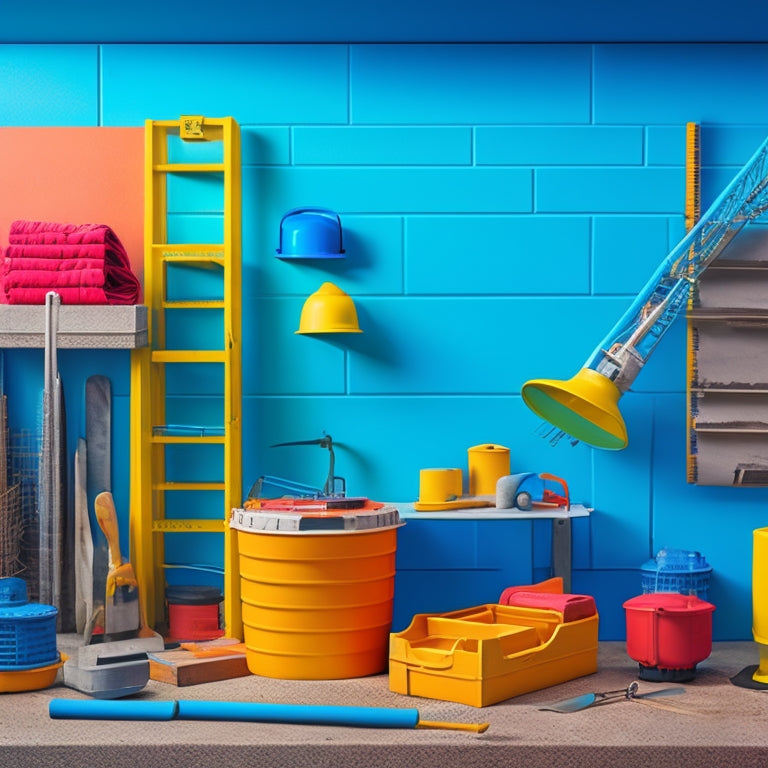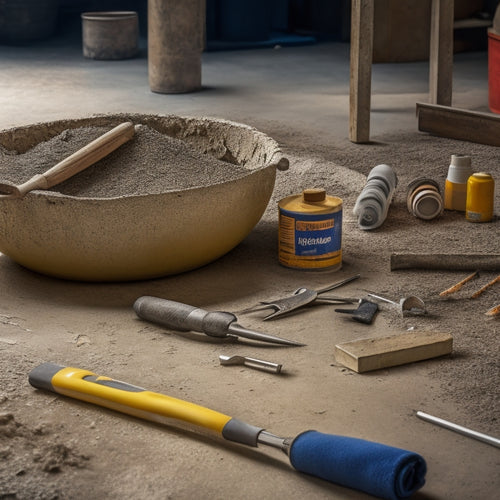
3 Must-Have Tools for Concrete Block Wall Construction
Share
When building a concrete block wall, you'll need three must-have tools to guarantee precision and quality. First, a precision level or transit is essential for leveling the foundation, securing a solid base for your wall. Next, a long spirit level or laser level will help you project a level line, ensuring straight walls, while a plumb bob will check vertical alignment. Finally, a block alignment tool is vital for maintaining consistent gaps between blocks and preventing deviations in wall alignment. With these tools, you'll be well on your way to building a sturdy, professional-looking wall, and understanding the intricacies of their application will take your construction to the next level.
Key Takeaways
• A precision level or transit is essential for ensuring the foundation is perfectly level and the wall is built on a solid base.
• A long spirit level or laser level helps project a level line for straight walls and maintain straightness during block placement.
• A plumb bob is necessary for checking the vertical alignment of walls and ensuring they are perfectly plumb.
• A block alignment tool is crucial for achieving consistent gaps between blocks and preventing deviations in wall alignment.
• A string line is vital for maintaining straightness during block placement and ensuring the wall is built with precision and accuracy.
Leveling the Block Wall Foundation
Before laying the first block, make certain the foundation is perfectly level by checking the elevation of the footing or slab with a precision level or transit, as even slight deviations can lead to a structurally unsound wall.
You'll need to conduct thorough foundation preparation to guarantee a solid base for your concrete block wall. This involves a soil assessment to determine the load-bearing capacity of the soil. Check for any signs of settlement or movement, and take note of the soil's density and moisture levels.
If you're building on unstable soil, you may need to install additional footings or foundation reinforcements to prevent future damage.
Once you've evaluated the soil, use a precision level or transit to check the elevation of the footing or slab. Make any necessary adjustments to achieve a perfectly level surface.
Ensuring Straight and Plumb Walls
With a level foundation in place, you can now focus on constructing straight and plumb walls by using a combination of leveling tools and careful block placement to make certain your wall remains true throughout the building process. To guarantee straight walls, use a long spirit level or a laser level to project a level line along the wall. This will help you identify any deviations from the desired plane.
For plumb walls, a plumb bob is an essential tool. Suspend the plumb bob from the top of the wall to check if it's perfectly vertical. You can also use a laser level to project a vertical line, making it easier to check the wall's plumbness.
Here are some key tools to help you achieve straight and plumb walls:
| Tool | Purpose |
|---|---|
| Spirit Level | Ensures wall is level and straight |
| Laser Level | Projects level and vertical lines |
| Plumb Bob | Checks wall's vertical alignment |
| String Line | Helps maintain straightness during block placement |
| Block Alignment Tool | Assists in maintaining block alignment |
Achieving Perfect Block Alignment
Accurate block alignment is essential to the structural integrity and aesthetic appeal of your concrete block wall, and it requires a combination of careful planning and the right tools.
You'll need to develop effective block layout strategies to guarantee that each course is properly aligned with the one below it. This involves carefully planning the layout of your wall, taking into account any obstacles, corners, or electrical outlets that may affect the alignment of your blocks.
To achieve perfect block alignment, you'll need to invest in the right alignment tools. A spirit level and a string line are essential for assuring that each course is level and plumb.
You may also want to take into account using a block alignment tool, which can help you maintain a consistent gap between blocks and prevent deviations in the wall's alignment.
Frequently Asked Questions
What Personal Protective Equipment Is Recommended for Concrete Block Wall Construction?
When working with concrete blocks, you'll need to prioritize your safety.
Start by following established safety guidelines to minimize risks.
Create a PPE checklist to guarantee you have the essential gear, including a hard hat, safety glasses, earplugs, dust mask, gloves, and steel-toed boots.
Don't forget a first-aid kit and a fire extinguisher on-site.
Can I Reuse Mortar That Has Been Exposed to Air?
You're standing on the construction site, gazing at the mortar mix that's been sitting out for hours, wondering if it's still usable.
But, just like a freshly baked cake left out too long, exposed mortar loses its potency. Reusing mortar that's been exposed to air can lead to weakened bonds and structural issues.
Follow the mortar reuse guidelines: if it's been more than 30 minutes to an hour since mixing, it's best to discard it.
Air exposure effects are irreversible, so it's better to err on the side of caution.
How Do I Prevent Mold and Mildew Growth on Concrete Blocks?
To prevent mold and mildew growth on concrete blocks, you'll want to control moisture levels.
Start by applying a moisture barrier to the blocks before construction to prevent water absorption.
Ascertain good ventilation in the wall cavity by installing ventilation systems, like weep holes or vents, to circulate air and reduce humidity.
This combo will help keep your blocks dry, making it difficult for mold and mildew to take hold.
What Is the Ideal Temperature for Laying Concrete Blocks?
Just like a master chef balances flavors, you'll need to balance the temperature when laying concrete blocks.
The ideal weather for block laying is between 40°F and 90°F (4°C and 32°C), with minimal temperature fluctuations.
Temperature effects on concrete can be drastic, so aim for a consistent temperature range to guarantee proper bonding and curing.
Avoid extreme temperatures, as they can compromise the structural integrity of your wall.
Can I Use a Hammer Drill to Drill Into Concrete Blocks?
When drilling into concrete blocks, you'll need the right tools to get the job done efficiently.
Can you use a hammer drill? Absolutely! However, you'll need to choose the right type of hammer drill and drill bit for the task.
Opt for a rotary hammer drill or a hammer drill with a masonry bit, and select a carbide-tipped or diamond-coated drill bit designed for concrete.
This combo will help you drill through concrete blocks with ease.
Conclusion
With these three must-have tools in your arsenal, you'll be well on your way to constructing a sturdy and visually appealing concrete block wall.
Remember, a level foundation is key, and ensuring straight and plumb walls is essential.
Take, for instance, the renovation of the historic City Hall building, where a masonry team used these tools to construct a new concrete block wall that perfectly complemented the original structure, earning rave reviews from city officials and passersby alike.
Related Posts
-

Top Tools for Repairing Cracked Concrete Surfaces
When tackling a cracked concrete surface repair, you'll need the right tools to guarantee a durable fix. Start with e...
-

Essential Power Tools for DIY Concrete Sculpting
As you begin DIY concrete sculpting, you'll need a strategic selection of power tools to achieve professional-grade r...
-

10 Best Tools for Sealed Concrete Finishing Success
When it comes to sealed concrete finishing success, you need a robust arsenal of specialized tools. Start with essent...


